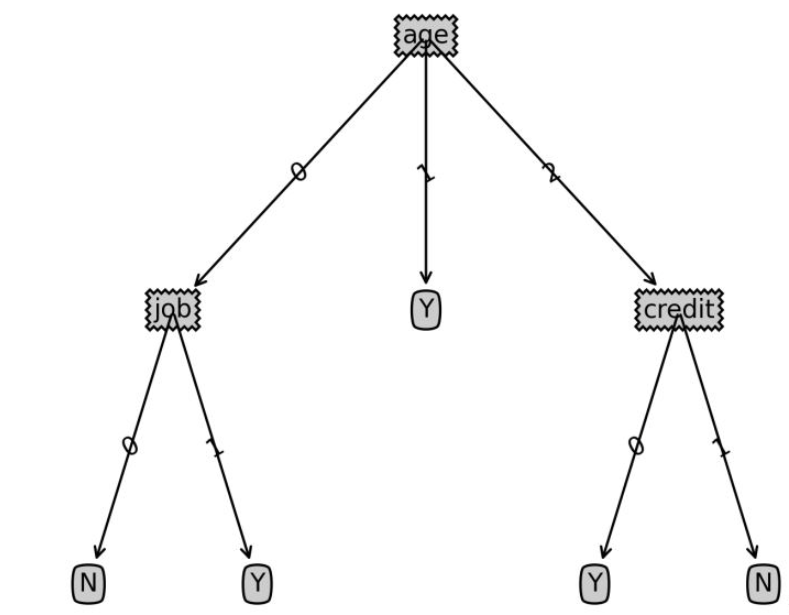前置信息
1、决策树
重写后的句子: 在监督学习中,常用的一种分类算法是决策树,其基于一批样本,每个样本都包含一组属性和对应的分类结果。利用这些样本进行学习,算法可以生成一棵决策树,该决策树可以对新数据进行正确分类
2、样本数据
假设现有用户14名,其个人属性及是否购买某一产品的数据如下:
| 编号 | 年龄 | 收入范围 | 工作性质 | 信用评级 | 购买决策 |
|---|---|---|---|---|---|
| 01 | 0c37f9e0d90946cfdef5d7404e6790a840 | 中等 | 不稳定 | 较差 | 是 |
| 05 | >40 | 低 | 稳定 | 较差 | 是 |
| 06 | >40 | 低 | 稳定 | 好 | 否 |
| 07 | 30-40 | 低 | 稳定 | 好 | 是 |
| 08 | 5adc9a016494749614d93c61c491a66240 | 中等 | 稳定 | 较差 | 是 |
| 11 | bcf2c01105c8dc678e5cd54091dc9b8040 | 中等 | 不稳定 | 好 | 否 |
策树分类算法
1、构建数据集
为了方便处理,对模拟数据按以下规则转换为数值型列表数据:
年龄:dd96a59f806b34d6c2eada4ccbf79c3c40赋值为2
收入:低为0;中为1;高为2
工作性质:不稳定为0;稳定为1
信用评级:差为0;好为1
#创建数据集
def createdataset():
dataSet=[[0,2,0,0,'N'],
[0,2,0,1,'N'],
[1,2,0,0,'Y'],
[2,1,0,0,'Y'],
[2,0,1,0,'Y'],
[2,0,1,1,'N'],
[1,0,1,1,'Y'],
[0,1,0,0,'N'],
[0,0,1,0,'Y'],
[2,1,1,0,'Y'],
[0,1,1,1,'Y'],
[1,1,0,1,'Y'],
[1,2,1,0,'Y'],
[2,1,0,1,'N'],]
labels=['age','income','job','credit']
return dataSet,labels调用函数,可获得数据:
ds1,lab = createdataset() print(ds1) print(lab)
[[0, 2, 0, 0, ‘N’], [0, 2, 0, 1, ‘N’], [1, 2, 0, 0, ‘Y’], [2, 1, 0, 0, ‘Y’], [2, 0, 1, 0, ‘Y’], [2, 0, 1, 1, ‘N’], [1, 0, 1, 1, ‘Y’], [0, 1, 0, 0, ‘N’], [0, 0, 1, 0, ‘Y’], [2, 1, 1, 0, ‘Y’], [0, 1, 1, 1, ‘Y’], [1, 1, 0, 1, ‘Y’], [1, 2, 1, 0, ‘Y’], [2, 1, 0, 1, ‘N’]]
[‘age’, ‘income’, ‘job’, ‘credit’]
2、数据集信息熵
信息熵也称为香农熵,是随机变量的期望。度量信息的不确定程度。信息的熵越大,信息就越不容易搞清楚。处理信息就是为了把信息搞清楚,就是熵减少的过程。
def calcShannonEnt(dataSet):
numEntries = len(dataSet)
labelCounts = {}
for featVec in dataSet:
currentLabel = featVec[-1]
if currentLabel not in labelCounts.keys():
labelCounts[currentLabel] = 0
labelCounts[currentLabel] += 1
shannonEnt = 0.0
for key in labelCounts:
prob = float(labelCounts[key])/numEntries
shannonEnt -= prob*log(prob,2)
return shannonEnt样本数据信息熵:
shan = calcShannonEnt(ds1) print(shan)
0.9402859586706309
3、信息增益
信息增益:用于度量属性A降低样本集合X熵的贡献大小。信息增益越大,越适于对X分类。
def chooseBestFeatureToSplit(dataSet):
numFeatures = len(dataSet[0])-1
baseEntropy = calcShannonEnt(dataSet)
bestInfoGain = 0.0;bestFeature = -1
for i in range(numFeatures):
featList = [example[i] for example in dataSet]
uniqueVals = set(featList)
newEntroy = 0.0
for value in uniqueVals:
subDataSet = splitDataSet(dataSet, i, value)
prop = len(subDataSet)/float(len(dataSet))
newEntroy += prop * calcShannonEnt(subDataSet)
infoGain = baseEntropy - newEntroy
if(infoGain > bestInfoGain):
bestInfoGain = infoGain
bestFeature = i
return bestFeature以上代码实现了基于信息熵增益的ID3决策树学习算法。其核心逻辑原理是:依次选取属性集中的每一个属性,将样本集按照此属性的取值分割为若干个子集;对这些子集计算信息熵,其与样本的信息熵的差,即为按照此属性分割的信息熵增益;找出所有增益中最大的那一个对应的属性,就是用于分割样本集的属性。
计算样本最佳的分割样本属性,结果显示为第0列,即age属性:
col = chooseBestFeatureToSplit(ds1) col
0
4、构造决策树
def majorityCnt(classList):
classCount = {}
for vote in classList:
if vote not in classCount.keys():classCount[vote] = 0
classCount[vote] += 1
sortedClassCount = sorted(classList.iteritems(),key=operator.itemgetter(1),reverse=True)#利用operator操作键值排序字典
return sortedClassCount[0][0]
#创建树的函数
def createTree(dataSet,labels):
classList = [example[-1] for example in dataSet]
if classList.count(classList[0]) == len(classList):
return classList[0]
if len(dataSet[0]) == 1:
return majorityCnt(classList)
bestFeat = chooseBestFeatureToSplit(dataSet)
bestFeatLabel = labels[bestFeat]
myTree = {bestFeatLabel:{}}
del(labels[bestFeat])
featValues = [example[bestFeat] for example in dataSet]
uniqueVals = set(featValues)
for value in uniqueVals:
subLabels = labels[:]
myTree[bestFeatLabel][value] = createTree(splitDataSet(dataSet, bestFeat, value), subLabels)
return myTreemajorityCnt函数用于处理一下情况:最终的理想决策树应该沿着决策分支到达最底端时,所有的样本应该都是相同的分类结果。但是真实样本中难免会出现所有属性一致但分类结果不一样的情况,此时majorityCnt将这类样本的分类标签都调整为出现次数最多的那一个分类结果。
createTree是核心任务函数,它对所有的属性依次调用ID3信息熵增益算法进行计算处理,最终生成决策树。
5、实例化构造决策树
利用样本数据构造决策树:
Tree = createTree(ds1, lab)
print("样本数据决策树:")
print(Tree)样本数据决策树:
{‘age’: {0: {‘job’: {0: ‘N’, 1: ‘Y’}},
1: ‘Y’,
2: {‘credit’: {0: ‘Y’, 1: ‘N’}}}}

6、测试样本分类
给出一个新的用户信息,判断ta是否购买某一产品:
| 年龄 | 收入范围 | 工作性质 | 信用评级 |
|---|---|---|---|
| <30 | 低 | 稳定 | 好 |
| <30 | 高 | 不稳定 | 好 |
def classify(inputtree,featlabels,testvec):
firststr = list(inputtree.keys())[0]
seconddict = inputtree[firststr]
featindex = featlabels.index(firststr)
for key in seconddict.keys():
if testvec[featindex]==key:
if type(seconddict[key]).__name__=='dict':
classlabel=classify(seconddict[key],featlabels,testvec)
else:
classlabel=seconddict[key]
return classlabellabels=['age','income','job','credit'] tsvec=[0,0,1,1] print('result:',classify(Tree,labels,tsvec)) tsvec1=[0,2,0,1] print('result1:',classify(Tree,labels,tsvec1))
result: Y
result1: N
后置信息:绘制决策树代码
以下代码用于绘制决策树图形,非决策树算法重点,有兴趣可参考学习
import matplotlib.pyplot as plt
decisionNode = dict(box, fc="0.8")
leafNode = dict(box, fc="0.8")
arrow_args = dict(arrow)
#获取叶节点的数目
def getNumLeafs(myTree):
numLeafs = 0
firstStr = list(myTree.keys())[0]
secondDict = myTree[firstStr]
for key in secondDict.keys():
if type(secondDict[key]).__name__=='dict':#测试节点的数据是否为字典,以此判断是否为叶节点
numLeafs += getNumLeafs(secondDict[key])
else: numLeafs +=1
return numLeafs
#获取树的层数
def getTreeDepth(myTree):
maxDepth = 0
firstStr = list(myTree.keys())[0]
secondDict = myTree[firstStr]
for key in secondDict.keys():
if type(secondDict[key]).__name__=='dict':#测试节点的数据是否为字典,以此判断是否为叶节点
thisDepth = 1 + getTreeDepth(secondDict[key])
else: thisDepth = 1
if thisDepth > maxDepth: maxDepth = thisDepth
return maxDepth
#绘制节点
def plotNode(nodeTxt, centerPt, parentPt, nodeType):
createPlot.ax1.annotate(nodeTxt, xy=parentPt, xycoords='axes fraction',
xytext=centerPt, textcoords='axes fraction',
va="center", ha="center", bbox=nodeType, arrowprops=arrow_args )
#绘制连接线
def plotMidText(cntrPt, parentPt, txtString):
xMid = (parentPt[0]-cntrPt[0])/2.0 + cntrPt[0]
yMid = (parentPt[1]-cntrPt[1])/2.0 + cntrPt[1]
createPlot.ax1.text(xMid, yMid, txtString, va="center", ha="center", rotation=30)
#绘制树结构
def plotTree(myTree, parentPt, nodeTxt):#if the first key tells you what feat was split on
numLeafs = getNumLeafs(myTree) #this determines the x width of this tree
depth = getTreeDepth(myTree)
firstStr = list(myTree.keys())[0] #the text label for this node should be this
cntrPt = (plotTree.xOff + (1.0 + float(numLeafs))/2.0/plotTree.totalW, plotTree.yOff)
plotMidText(cntrPt, parentPt, nodeTxt)
plotNode(firstStr, cntrPt, parentPt, decisionNode)
secondDict = myTree[firstStr]
plotTree.yOff = plotTree.yOff - 1.0/plotTree.totalD
for key in secondDict.keys():
if type(secondDict[key]).__name__=='dict':#test to see if the nodes are dictonaires, if not they are leaf nodes
plotTree(secondDict[key],cntrPt,str(key)) #recursion
else: #it's a leaf node print the leaf node
plotTree.xOff = plotTree.xOff + 1.0/plotTree.totalW
plotNode(secondDict[key], (plotTree.xOff, plotTree.yOff), cntrPt, leafNode)
plotMidText((plotTree.xOff, plotTree.yOff), cntrPt, str(key))
plotTree.yOff = plotTree.yOff + 1.0/plotTree.totalD
#创建决策树图形
def createPlot(inTree):
fig = plt.figure(1, facecolor='white')
fig.clf()
axprops = dict(xticks=[], yticks=[])
createPlot.ax1 = plt.subplot(111, frameon=False, **axprops) #no ticks
#createPlot.ax1 = plt.subplot(111, frameon=False) #ticks for demo puropses
plotTree.totalW = float(getNumLeafs(inTree))
plotTree.totalD = float(getTreeDepth(inTree))
plotTree.xOff = -0.5/plotTree.totalW; plotTree.yOff = 1.0;
plotTree(inTree, (0.5,1.0), '')
plt.savefig('决策树.png',dpi=300,bbox_inches='tight')
plt.show()以上是python如何实现决策树分类算法的详细内容。更多信息请关注PHP中文网其他相关文章!
 Python中有可能理解吗?如果是,为什么以及如果不是为什么?Apr 28, 2025 pm 04:34 PM
Python中有可能理解吗?如果是,为什么以及如果不是为什么?Apr 28, 2025 pm 04:34 PM文章讨论了由于语法歧义而导致的Python中元组理解的不可能。建议使用tuple()与发电机表达式使用tuple()有效地创建元组。(159个字符)
 Python中的模块和包装是什么?Apr 28, 2025 pm 04:33 PM
Python中的模块和包装是什么?Apr 28, 2025 pm 04:33 PM本文解释了Python中的模块和包装,它们的差异和用法。模块是单个文件,而软件包是带有__init__.py文件的目录,在层次上组织相关模块。
 Python中的Docstring是什么?Apr 28, 2025 pm 04:30 PM
Python中的Docstring是什么?Apr 28, 2025 pm 04:30 PM文章讨论了Python中的Docstrings,其用法和收益。主要问题:Docstrings对于代码文档和可访问性的重要性。
 Python的通行证是什么?Apr 28, 2025 pm 04:25 PM
Python的通行证是什么?Apr 28, 2025 pm 04:25 PM本文讨论了Python中的“ Pass”语句,该语句是函数和类等代码结构中用作占位符的空操作,允许在没有语法错误的情况下实现将来实现。
 Python中的 /和//有什么区别?Apr 28, 2025 pm 04:21 PM
Python中的 /和//有什么区别?Apr 28, 2025 pm 04:21 PM文章在Python中讨论 /和//运营商: / for for True Division,//用于地板部门。主要问题是了解它们的差异和用例。Character数量:158


热AI工具

Undresser.AI Undress
人工智能驱动的应用程序,用于创建逼真的裸体照片

AI Clothes Remover
用于从照片中去除衣服的在线人工智能工具。

Undress AI Tool
免费脱衣服图片

Clothoff.io
AI脱衣机

Video Face Swap
使用我们完全免费的人工智能换脸工具轻松在任何视频中换脸!

热门文章

热工具

EditPlus 中文破解版
体积小,语法高亮,不支持代码提示功能

SublimeText3 英文版
推荐:为Win版本,支持代码提示!

Dreamweaver Mac版
视觉化网页开发工具

WebStorm Mac版
好用的JavaScript开发工具

SecLists
SecLists是最终安全测试人员的伙伴。它是一个包含各种类型列表的集合,这些列表在安全评估过程中经常使用,都在一个地方。SecLists通过方便地提供安全测试人员可能需要的所有列表,帮助提高安全测试的效率和生产力。列表类型包括用户名、密码、URL、模糊测试有效载荷、敏感数据模式、Web shell等等。测试人员只需将此存储库拉到新的测试机上,他就可以访问到所需的每种类型的列表。









